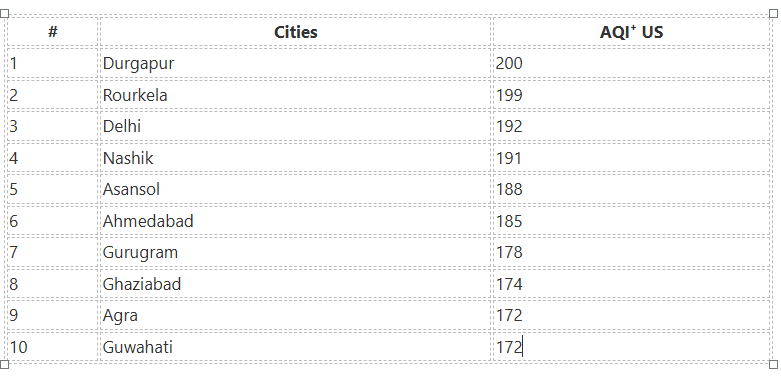Pollution, especially air pollution, has become one of the most pressing environmental challenges in India. Several Indian cities consistently rank among the most polluted in the world due to rapid urbanization, industrialization, vehicular emissions, and biomass burning.
1. Current Status of Pollution in Indian Cities
According to reports from the World Air Quality Report 2023 (by IQAir) and the Central Pollution Control Board (CPCB), multiple Indian cities feature among the world’s most polluted.
Top Polluted Cities in India (2024)
As per recent data, some of the most polluted cities (based on PM2.5 levels) include:
- Delhi is one of the most polluted capitals in the world.
- Begusarai (Bihar) – High industrial and vehicular pollution.
- Muzaffarpur (Bihar) – Severe air quality issues.
- Patna (Bihar) – High pollution from transport and biomass burning.
- Ghaziabad (Uttar Pradesh) – Industrial and vehicular pollution.
- Noida (Uttar Pradesh) – Construction and industrial pollution.
- Agra (Uttar Pradesh) – Pollution from tourism, transport, and industries.
- Kanpur (Uttar Pradesh) – High pollution due to industries and vehicles.
- Jaipur (Rajasthan) – Dust storms and vehicle emissions.
- Ludhiana (Punjab) – Pollution from industries and stubble burning.
These cities frequently record PM2.5 levels much higher than the World Health Organization (WHO) safe limit of 5 µg/m³.
India’s Most Polluted City Ranking 2025
Check the list of most polluted cities and rankings.
| # | Cities | AQI⁺ US |
|---|---|---|
| 1 |
Durgapur
|
200
|
| 2 |
Rourkela
|
199
|
| 3 |
Delhi
|
192
|
| 4 |
Nashik
|
191
|
| 5 |
Asansol
|
188
|
| 6 |
Ahmedabad
|
185
|
| 7 |
Gurugram
|
178
|
| 8 |
Ghaziabad
|
174
|
| 9 |
Agra
|
172
|
| 10 |
Guwahati
|
172
|
2. Major Causes of Air Pollution in Indian Cities
-
Vehicular Emissions
- Rapid urbanization has led to increased vehicle usage.
- Older vehicles and lack of emission control contribute to high pollution.
-
Industrial Pollution
- Power plants, refineries, and manufacturing units release pollutants like sulfur dioxide (SO₂), nitrogen oxides (NOx), and particulate matter (PM2.5, PM10).
-
Construction Activities
- Urban expansion leads to increased dust and suspended particulate matter.
- Lack of proper waste disposal worsens pollution levels.
-
Stubble Burning (Parali Burning)
- Common in Punjab, Haryana, and Uttar Pradesh before the winter season.
- Leads to severe smog in Delhi-NCR.
-
Household and Biomass Burning
- Use of wood, coal, and dung cakes for cooking in rural and urban slums increases air pollution.
-
Geographical and Climatic Factors
- Winter inversion traps pollutants, especially in northern India.
- Lack of wind movement leads to pollution accumulation.
-
Waste Burning
- Unregulated burning of plastic, garbage, and medical waste releases toxic fumes.
3. Impact of Pollution on Health and Environment
A. Health Effects
- Respiratory Diseases – Asthma, bronchitis, lung infections.
- Cardiovascular Issues – Increased risk of heart attacks and strokes.
- Neurological Disorders – Air pollution linked to cognitive decline.
- Children & Elderly at Risk – Weak immune systems make them more vulnerable.
B. Environmental Impact
- Climate Change – Pollutants like black carbon contribute to global warming.
- Crop Damage – Air pollution reduces agricultural productivity.
- Water Contamination – Pollutants settle in water bodies, affecting aquatic life.
4. Government Measures to Combat Pollution
A. Legislative & Policy Initiatives
-
National Clean Air Programme (NCAP) (2019)
- Aims to reduce PM2.5 and PM10 levels by 20-30% by 2024.
- Targets 122 non-attainment cities with high pollution levels.
-
Air (Prevention and Control of Pollution) Act, 1981
- Legal framework to monitor and control air pollution.
-
Environment Protection Act, 1986
- Empowers the government to take necessary steps against pollution.
B. Technological & Scientific Measures
-
Graded Response Action Plan (GRAP)
- Implemented in Delhi-NCR to take emergency measures like vehicle bans, construction halts, and odd-even schemes.
-
Switch to Cleaner Fuel
- Bharat Stage (BS-VI) Emission Standards – Stricter norms for vehicle emissions.
- Promotion of CNG, electric vehicles (EVs), and green hydrogen.
-
Smog Towers
- Installed in Delhi to reduce air pollution in localized areas.
-
Bio-Decomposers
- Used to manage stubble burning in Punjab and Haryana.
C. Sustainable Urban Development
-
Promotion of Public Transport
- Expansion of Metro Rail, electric buses, and cycling infrastructure.
-
Afforestation & Urban Green Spaces
- Increased tree plantations to act as carbon sinks.
5. Way Forward – Solutions for a Cleaner India
- Stronger Enforcement of Laws – Strict action against industries and vehicular pollution violators.
- Encouraging Renewable Energy – Greater focus on solar and wind power.
- Public Awareness Campaigns – Encouraging citizens to adopt eco-friendly practices.
- Better Urban Planning – Creation of low-emission zones, pedestrian-friendly areas, and improved waste management.
- Scientific Innovations – Use of AI and IoT for real-time pollution monitoring.
Air pollution in Indian cities is a severe public health and environmental crisis. While government initiatives like NCAP, GRAP, and BS-VI norms have made some progress, sustained efforts, strong enforcement, and public participation are necessary to achieve clean air goals. Addressing this issue is crucial for sustainable development and environmental justice, aligning with India’s commitment under the Paris Agreement and SDGs (Sustainable Development Goals).

